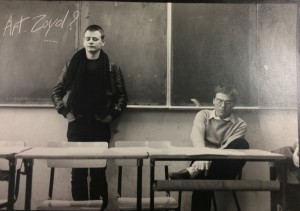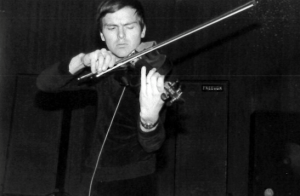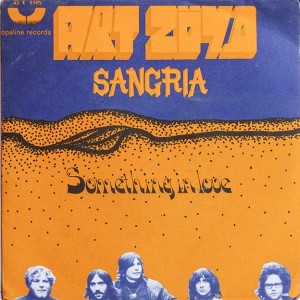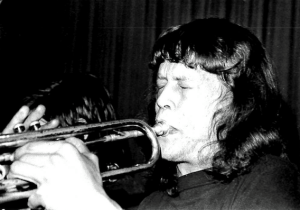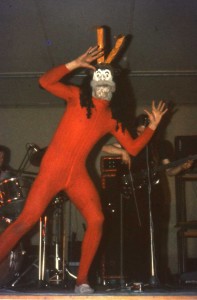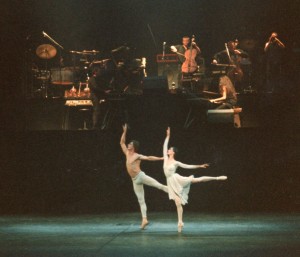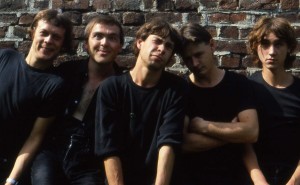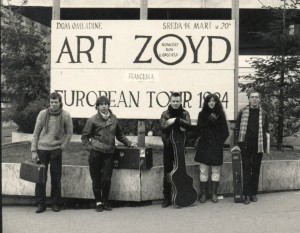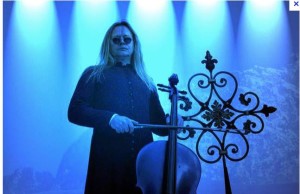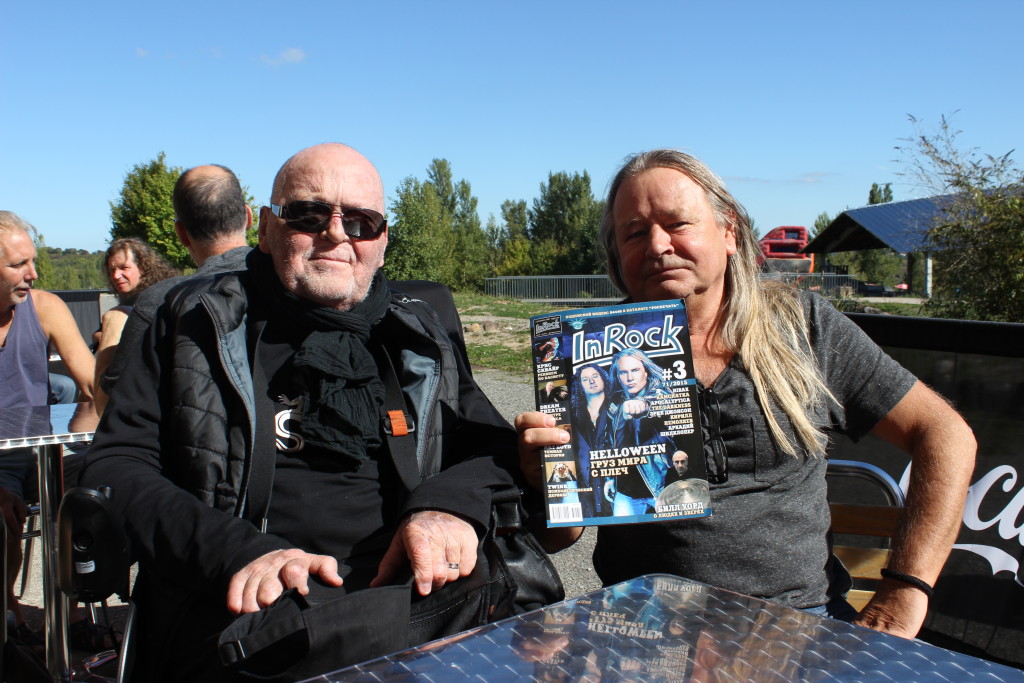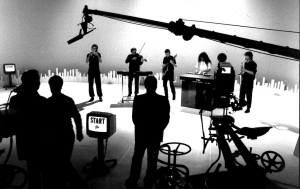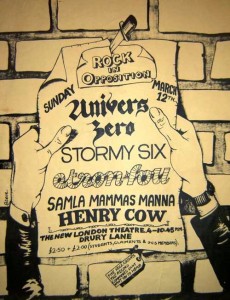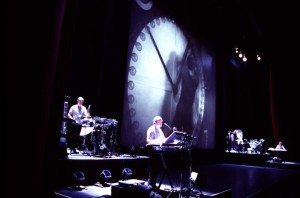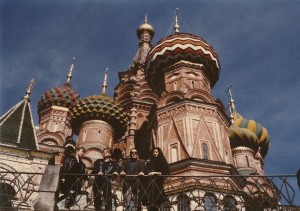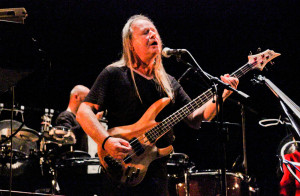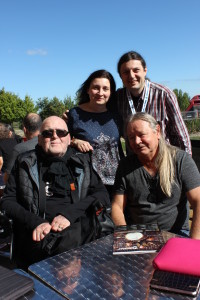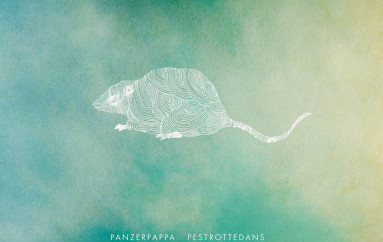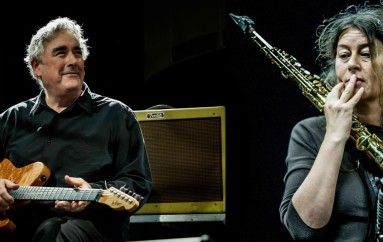
Thierry Zaboitzeff and Gérard Hourbette (Art Zoyd): Music is like bridges
French avant-progressive band Art Zoyd has a huge legacy and remains an active, although not very often, performing unit. Last year the band played a stunning gig at Rock In Opposition Festival 2015 (France, Albi, Cap D’Couverte): 2,5 hours of music, ten outstanding musicians on stage, including two masterminds of the band, bassist/cellist Thierry Zaboitzeff and violinist Gerard Hourbette, who haven’t been playing together since 1997. And on December 7th 2016 the band is going to play one more reunion show in Art Zoyd’s home town of Valenciennes! A huge event that inspired us to publish following huge text.
Telling the story of Art Zoyd is a tremendous task. Asking the musicians themselves is an amazing chance we had twice. The first was when Thierry Zaboitzeff kindly agreed to answer our questions by email. The second, when we met face-to-face with him and Gerard Hourbette the day after their triumphant gig at RIO Festival’2015. The first conversation became a basis for feature story in «InRock» magazine (issue #3(71)/2015). The second part was waiting it’s time till now. Instead of merging them in a chronological manner, we decided to leave them «as is», because every detail is important and there isn’t so much of English-language interview with Art Zoyd at all. So, we have a truly unique material, which is necessary to share with all prog / avant rock fans.
Thierry, please tell us about your pre-Art Zoyd history. Where and when were you born?
I was born July 27, 1953 in Maubeuge, a small town in northern France, neighboring Belgian border, between industrial and rural areas.
Your surname sounds very Russian. Do you have any Russian or other Slavic roots?
My paternal grandfather was Russian, from Arkhangelsk region. He was naturalized French and spent half of his life in France.
What education you had, music & general?
I didn’t really study music, though sometimes I went with my grandfather (the other, not Russian) to the church, where, on the gallery, he played organ during liturgies, weddings and funerals. Really impressive it was for a child that I was these days.
What were your inspirations and reasons for become a musician?
At the very beginning of my adolescence, I got really interested in amateur music, then in rock, but not that of Presley & Co. but that of Bob Dylan, The Beatles, Rolling Stones, Jimi Hendrix, etc. Then, for a short while, I become interested in the very first compositions of Pink Floyd, then Soft Machine, Frank Zappa, Miles Davis… And step by step I discovered other composers such as Bartok, Stravinsky, Varese, Pierre Henry, Berio, Kagel…
At that time I began to feel the strong need to be in music but with the firm conviction that it would not be imitating others. These feelings were very vague, diffused at that time.
Was it also a time when you met Gerard Hourbette?
We lived in the same town. I met Gerard one day in my wanderings. And from that moment everything accelerated. Gerard had a classical background and studied violin at the conservatory, and I was an amateur guitar player, inexperienced but ready for everything. We were both in search of various experiments (prepared guitars, violins into the echo, various analog sound effects, distorted sounds but also spacey sometimes…)
Our first group was just born, we named it «Dream 1». Duo which made a trio a few weeks later with bassist Guy Judas, whom I don’t have any news about.
A few months later, Gerard met Rocco Fernandez in a music store in the town near Valenciennes. Rocco was immediately intrigued by the looks of Gérard (shaved head, fur coat, many necklaces and bracelets and a violin under his arm).
They became acquainted, we became acquainted and almost the next day we joined the Art Zoyd.
There is different information about time when Art Zoyd was formed. Wikipedia mentions 1968, artzoyd.net website – 1969, your own website – 1971 (the year when you joined the band). And the name of the current tour, «44 ½», probably points at 1971…
Confusion, sorry! Art Zoyd was born in 1969, and Gérard and I joined the band in 1971. The name of this project (44 ½) is this birthday.
Sorry for the primitive question: what does the name “Art Zoyd” mean and who was the author of the name?
This name was created by Rocco Fernandez and the manager of Opaline Records before release of «Sangria» – the first single of Art Zoyd. Originally, the group was called Experimental Music. Not a very original name!
They thought that the name had to reflect a little bit of the strange (bizarre in French) side of the music. They gathered around a table to find a name which would sound strange enough, so to say, «bizarre». Suddenly they found the word bizarroïd, then by inverting some letters they got arzoïd. This invented word reminded the art of zoïd. After some small researches, they decided for more attractive and more mysterious Art Zöyd.
Why the band was titled «Art Zoyd III» for a while?
It became Art Zoyd III when Gérard and I arrived. «III» because it was the third change of line-up. We returned to simple Art Zoyd a little bit later. This completely invented name was made to intrigue and make speak. I believe that it is very successful and it also pleases graphically.
How did you start to playing bass?
When we started, there were few very exciting rehearsals with Rocco making sort of local Frank Zappa in his musical approach and looks. Then a few weeks later our bass player (Guy Judas) left us. We had to quickly replace him, but we could not find anybody and Rocco asked me to keep the bass in the band, which I did with great pleasure and pride. But I had a difficult task to learn it…
But you liked it nevertheless.
Yes, I really like this instrument. Its role became even more important since we decided to work without battery, after the departure of Rocco, and the bass found a place as a rhythmic, melodic, percussion instrument…
And when you started to play cello?
The cello came for the album «Musique pour l’Odyssée». I was impressed and attracted by the sounds that Gérard produced on his viola, so, as I wanted more diversity in tone quality for strings, I made a step. He offered me a cello and I almost gave up so many times, so difficult was to learn to play it, but I persevered and I am very happy today.
Where the trumpet player, Jean-Pierre Soarez, came from?
Jean-Pierre Soarez joined us in 1973. At that time Jean-Pierre played in different cover bands. We had heard about him for his crazy improvisations and interventions here and there. A friend musician presented him to us and we stay together until 1985.
He has a very particular manner of playing the trumpet, with a lot of tension, but also subtlety. It was and it is again very important to work with him. He has a lot to do with the specific sound of Art Zoyd.
Please tell more about mysterious Rocco Fernandez…
In our region, Rocco Fernandez was nicknamed «Franck Zappa of the North» because of his looks and of his funny side and his musical provocations. I owe to him a lot, I learned from him enormously. He was inventive and pushing forward constantly.
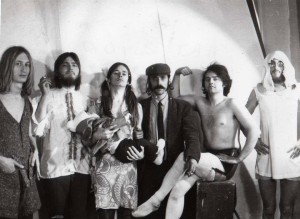
Art Zoyd… Art Zoyd? Art Zoyd!!!
Why he left Zoyd Art in 1975 and what he’s up to now?
After seven years of tours and very enriching and badly paid concerts, Rocco had a big wave of tiredness. He lost any desire, any motivation and decided calmly to leave the group and the music generally. He gave the direction of Art Zoyd to Gérard and me.
From your first «Sangria» EP (1971) to «Symphonie pour le jour où brûleront les cités» (1976) you changed radically – from heavy psychedelia to chamber/avant rock. Almost no rock instruments besides bass, no drums… How brave/scary it was to abandon usual rock methods and, literally, “burn the cities” behind you?
After Rocco left us, we wished to question ourselves. We were very tired of doing the compositions with this continual pulsation of drum kit and clichés of jazz rock. We dreamt about other, more unstable, flexible things, playing with the differences of dynamics without being fixed between hi-hat, snare drum, bass drum and rains of cymbals. We began to experiment, to give unusual roles to instruments – bass, two violins, trumpet… And the result for us was magnificent, the sound seemed unique to us.

Playing in small clubs…
Why so “apocalyptic” title of the album — «Symphonie pour le jour où brûleront les cités» («Symphony For the Day When the Cities Will Burn”)?
Our decision was don’t write pop songs. Every step forward went towards a research, a modernity and an own sensibility. We had to try to break the codes, our codes. Our music at that time was talking about the oppression of urban areas, the dictatorships, the surveillance, etc.
Was the music somehow influenced by Olivier Messiaen’s «Quartet for the End of Time»?
Personally – not. Although we love this composer and many others, such as Bartok, Stravinsky…
Your music, especially then, is full of dark, sinister, scary moods and dissonant harmonies. Were you really seeing the world in black back then?
This was not only our vision, the world was like this, still is! I admit that we were particularly moody at that time, but in general I think we liked it! We loved these scraping, aggressive harmonies, these syncopated and irregular rhythms. We made provocation almost a duty and broke precepts, dogmas of rock music. We were looking for another rock, integrating European roots, jazz, classical, contemporary, experimental…
In fact, what most attracted us in rock music was energy, electric power of the instruments.
Was there a place for humor in music then? By the photos of early concerts – sure it was!
Yes, along with our black and dissatisfied side, we were a band of guys enjoying a good laugh, including at ourselves and our music. It could be seen on stage between two serious pieces, for example, during Rocco Fernandez times (1971-75). We were imitating idiotic rock bands and pop radio stations. Later, in 1976’s album, we took old compositions to the extreme, making a caricature of them in «Les Fourmis/Scènes de Carnaval». I remember these instrumental humoristic performances were played next to dark and serious pieces and the audience enjoyed this, as much as we did so!
Which language did you sing there? Kobaian, maybe?
No! No Kobaïen language here. At the time of Rocco Fernandez, there has been the temptation of singing Zoydien («Sangria»). This idea was soon forgotten!
Personally I often had the desire to use the voice. Because I find that voice that is singing, chanting, shouting, whispering has an extraordinary emotional power in music. I did not want to write songs with clear texts. In my opinion it did not suit our music, I was more interested in the organic side of the sound of voice.
Being self-taught, I composed on my bass, guitar, cello or rather on a piano. When I was looking for specific intonations, I imitated instrumental parts by the sound of my voice. One day, I recorded myself working this way, so I discovered the possibility of using my voice along the music. The voice became a real instrument with different registers.
At first, I worked with pronouncing nonsense sounds, which echoed the other instruments, like words without meaning. Later I started to inventing words that sounded organic to bring certain structure, to allow these words to be pronounced each time in the same way. It’s like a text, an ancient text that we could no longer find the meaning.
In 1983 you met Roland Petit. How it happened, what the meeting was like? How it was working with him on «Le Mariage du Ciel et de l’Enfer»?
One night after a rehearsal, Roland Petit returned home and turned on his television which was broadcasting one of our concerts, «Phase IV», specially filmed by FR3 Channel.
He was so touched, so impressed by the music that he telephoned immediately to get our contacts. A few days later we met in Paris and he commissioned us the music for his next ballet that would become «The Marriage of Heaven and Hell». And he asked us to be present on stage. He added: «Call it what you want, I love your music, I want to dance [to it]». We could not get better compliment!
Was he giving you any instructions musically or you decided everything for yourselves?
In the same time we were preparing a European tour with new repertoire, having some compositions in state of development. We agreed to record our concerts and to inform him in that way regularly of the evolution of our compositions. Roland Petit worked with those fragments and ideas we sent him. As soon as the entire suite was completed, we polished the music in the studio.
How it was to move from small clubs to big prestigious theaters? Why your music, being still very avant-garde by its nature, achieved success among the masses?
We have often thought about that. Our music had not seriously changed. I think that «The Marriage of Heaven and Hell» is essential piece of Art Zoyd, it is a very strong point in our career and now we realize that our music, when associated to another medium, only multiplies its strength. It offered us new aspects and new ears not easily conquered otherwise.
It was a big change in the transition from small venues to large prestigious theaters. But great pleasure that our music has found a wide response.
You did several works with silent movies of 1920’s: «Nosferatu», «Faust», «Häxan», and also «The Cabinet of Dr. Caligari» now. What is so close to you in the expressionism, in all these «horror» aesthetics?
In my case, it is not only aesthetics. Of course we kept this atypical side, this attraction to the abnormal, fantastic… Yes, these films are masterpieces of their time and of expressionism, but what I find most interesting is the possibility to see these films in other than their original context. Art Zoyd’s film-concerts don’t work in the usual sense of movie soundtrack. They act in primordial way – of course, the film orders the action, it is our conductor, but its power is being limited by image only, no dialogue, no sound, which leaves a very interesting place for our art, allowing to bring different perspectives, to precede, to destabilize, to divert, to create more layers with the magic of the music.
Why did you leave the band in 1997?
We were together since 1971 and since 1989 we made one concert film projects after another: «Nosferatu», «Faust», «Häxan»… I felt that there was a certain routine. Then, in 1997, I dreamt of other things and I became tired and very impatient. On the other hand, Gerard wanted to move more towards contemporary music and to organize composer residencies, which did not suit me at all. I needed to move, to explore other universes, new experiences that I would not get if I stayed. So I left! And it was really painful!
Your solo works show broad specter of styles from new age and ethno-trance to electronic minimalism and sympho rock. In whole, it feels like you decided to make a step towards more clear and simple music. Why?
I had nothing planned, I had just been a little more curious than before and opened myself to other people and artists who supported me and helped me to achieve the result in new projects. I was hot, I wanted everything… There has never been the question of a «simpler, clearer music». Sometimes there were precise requests that I dealt with my professional expertise. I never felt different from before. I just allowed myself all I want in music, including, like now, a return to the aesthetics of Art Zoyd. I feel a great pleasure to do it.
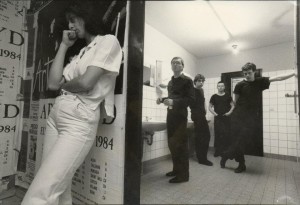
Patricia Dallio — keyboards, sampling — and… the guys from the band (photo: Philippe Bétrancourt, 1984)
Your solo projects are one-man-band mostly. One of the exceptions is «Missa Furiosa» by Zaboitzeff & Crew. Do you prefer working alone or with other musicians?
I must confess that for a long time, I could not bear the thought of a group, with its emotional tension, egocentrism, a group that was like a political party with its rules, its program which we could not depart.
I made «Missa Furiosa» with the group because I had received the budget for such a project and in this case, I was the leader (leader of the party!) and I did not intend to spend my life with this group because I could not physically make it last. But for me it was a great time with these musicians and singers.
I also enjoyed solo work, there are so many challenges in it, in the instrumental area and in juggling between songs, loop machines, cello, bass etc. It’s funny… and economically very viable.
What instruments do you play now, what modern technologies do you use?
Bass guitar, cello, guitars, percussion, keyboards, virtual samplers, multiple manipulations + DAW plug-ins (Logicx / MachFive 3 / Digital Performer). Nothing in fact is totally modern! Just a continuation.
What solo works are most important for you, most successful creatively?
Without mentioning my collaborations with theater, dance, etc. – my first two albums: «Prometheus / Dr. Zab», «Missa Furiosa / Sixteenth» and then my solo concert «Cross the Bridge». Lately, the concert film «The Cabinet of Dr. Caligari».
Why you re-joined Art Zoyd? Is it for long, or just for this year RIO fest performance?
Gerard and I wanted to play once more or to make somebody play Art Zoyd 1975-2015 repertory. We decided to bring together former bandmates and the current Art Zoyd team. We contacted, we met and we found each other just as 20 years ago. And quickly began to work on it. RIO proposal accelerated the process.
Who is the driving force behind reunion?
Art Zoyd is the driving force of the project that Gerard and I have created, supported by the RIO and Michel Besset. And a great team of musicians: Serge Bertocchi on saxophones, Romuald Cabardos on percussion and pads, Daniel Denis on percussion and pads; Yukari Hamada-Bertocchi on keyboards; Gérard Hourbette, samplers; Daniel Koskowitz on percussion, pads, guitar; Michael Nick on violin; Nadia Ratsimandresy on keyboards; Jean-Pierre Soarez on trumpet; Thierry Zaboitzeff on bass, cello, voice. Sylvie Debare as technical director and lights; Pierre Sampagnay – sound; Florent Meunier – backline…
How the rehearsals are going? How you change old material to play now?
Firstly we worked on the editing of new scores and programming samplers and now we rehearse in small groups. In August 2015 we finally got together for 10 days. We have decided to respect the sound and arrangements of each era.
Thank you so much for the answers!
The second part of unpublished material is a face-to-face conversation with Thierry Zaboitzeff and Gérard Hourbette, held on the day after the show at RIO-festival (Cap’Decouvert, Albi, France) in September 2015. Beautiful place, sunny day, and these great musicians in front of us. Another participant of the interview was an actress, choreographer and producer (and Thierry’s wife) Editta Braun, who kindly provided the translation from French into English and viсe versa.
We are happy to finally see you here! Thank you so much for agreeing to do the interview. Let’s start with yesterday’s performance, because it was so astonishing. How hard it was to prepare everything, to rehearse, to memorize all the parts?
Thierry: We had this project in the head for some years. We were cleaning the studio and found a lot of material. It was on magnetic tape and we copied it to contemporary technique. We have noticed there was a big mess. We also found some notes and did photocopies of them. So in fact everything started by cleaning the studio. In the beginning we thought it will be quick, but when we started to rehearse with the musicians we realized there will be huge work. And it was difficult to choose out of this huge amount of pieces what to play. We choose together. If not, the performance would have 44 hours and a half (laughs).
What were the criteria of choosing?
Thierry: It was difficult because we have so much important pieces, and going back to history we found that we become connected emotionally with the past. And we decided like grown-up people. (Laughs). As Art Zoyd had a great evolution we decided to choose some pieces from each period. We reconstructed the pieces and did a medley with some of them.
Gerard: Of course when we did this medley we had to shorten them and then to choose again.
How it was to work together after all that years?
Gerard: It’s like it would have been yesterday. Everything was back.
Thierry: It was easy to communicate. And the other musicians came with their ideas. Everybody came with what he knows and what he doesn’t know. And we haven’t changed so much as the musicians.
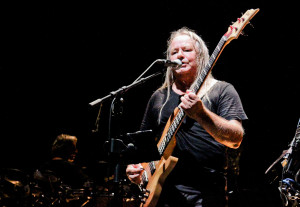 Was it difficult to perform the tracks from the very first albums?
Was it difficult to perform the tracks from the very first albums?
Gerard: As I am a violinist I didn’t realize that it will be really difficult to reproduce some of my parts (at the RIO-festival concert violin parts were performed by Michael Nick, – InRock). It was so unusual way of performing! It was not easy for us.
Thierry: And if I would have been to explain to another bassist how to play my parts it would have been lost. The rock energy is such a thing that is very difficult to explain by words! In the very beginning we were composing together with the instruments in our hands. We were sitting in the studio for hours and composing there. So music was born not in the head but in the fingers.
Gerard: We were playing these pieces like we were talking. No scores!
But how did your record them without scores and sheet music – was it all in your minds?
Thierry: It’s like an actor remembering the text.
Gerard: The music will be much more interesting if all musicians in general will be able to perform without scores. But it needs a lot of time to memorize.
Thierry: Because every time you have a delay between what you read and what you play. And you have no idea what happens with your body. It needs the whole body being a part of music. So I didn’t want to limit myself with scores, because it would change the music.
But your music has very difficult rhythmical structures, it seems like you need to count all the time…
Yes! (Everybody laughs).
How do you manage not to miss a beat?
Gerard: Music is also numbers. When we started there were no computers, but we had them in our heads. Music is also like architecture. So we construct a building with sounds. And also we have more complicated pieces and less complicated.
Who is your favorite classical composer?
Gerard: Personally I love Xenakis for his primitive violence and architectural thinking. I listened to many records and read many books. I’m very curious.
Thierry: For me in the very beginning it was Stravinsky, his dissonances and polyrhythmic combinations. We also wanted to combine the energy of rock and the background of European music, which is far from blues.
We have some more questions to Gerard about his musical background. Why did you choose the violin?Is that true that you decided to play music when you’ve read the musical vocabulary?
Gerard: (Laughs.) I started at the age of seven in the conservatory. I wanted to be a really good and famous violin player. I moved to Paris at the age of sixteen to continue my study. Then I discover the nowadays music and I was very disappointed [by classics]. I was a little bit lost when I left the conservatory. I was playing in the streets – the blues, improvisations… Then I came back to the North of France and somebody told me that somebody is interested in me. It was Thierry. We met and decided to play together. We formed a group of three musicians just in ten days or so. It was the first time when I played with the amplifier. Voila! And after that we founded Art Zoyd. It’s interesting that many of those who finished the conservatory are often not be able to play rhythmically and to understand the rhythmic complex. Normally rhythm is something you have in your head and in the same time you can pop it to another…
So classical music education didn’t give you the opportunity to learn how to play rock?
Gerard: No. I started to learn it afterwards. I liked rock music: Soft Machine, King Crimson…
 But did the classical foundation you’ve got in the conservatory help you later on to create those great albums with Art Zoyd?
But did the classical foundation you’ve got in the conservatory help you later on to create those great albums with Art Zoyd?
Gerard: Yes, nevertheless. But more important was listening to a lot of music. And of course the solfeg… sol-fa… оkey, like this (singing) do-re-mi-fa-sol help you to understand the music, if you know this. You need ears but you also need a brain (laughs).
Can we ask you about Rock In Opposition movement? How had you become involved in it, how did you decide to join?
Thierry: Rock In Opposition movement have existed since 1978 with Henry Cow and Univers Zero, Samla Mammas Manna from Sweden and Stormy Six from Italy. Personally I played bass with Daniel Denis of Univers Zero. Once I met Chris Cutler, and several months later we discussed integrating Art Zoyd into the movement. We played different festivals in Milano, in Switzerland… And the basis was to find different way to present our music. The most important was to exchange the ideas with others, and also to communicate with the audience which is far from the mainstream. In fact Rock In Opposition was a movement to be against the mainstream, to oppose the labels who didn’t want to give any artistic freedom to the musicians. RIO created their own way of communicating through festivals, our own label and so on. It was not an aesthetic movement, it was a political movement. Political in the means of art. It was against show-biz, against commercial music.
Gerard: We started to tour to help each other by organizing concerts. It was very successful in Eastern Europe which was normally closed by the Iron Curtain.
Original RIO PosterSpeaking about politics, did you share RIO political manifests?
Gerard: Politics is in the music for me. The aesthetical protest could be stronger than political.
Thierry: We have no texts, no lyrics, and we don’t want them (laughs).
Gerard: And maybe the violence is in the music. Sometimes the titles give political direction and associations for people. Sometimes some sounds. For example, the first piece of «Symphonie pour le jour où brûleront les cités» (1976) starts with sounds of people growling and fighting (we can hear the wild growling and groaning in the beginning of the composition, – InRock).
Thierry: Sometimes guys in the public were crying – agrhhh! (Laughs.) For us it wasn’t necessary to speak about politics. We do it simply with the music. Art Zoyd on stage was our politic acts – like commandos against the system.
So you were fighting with the help of music.
Thierry: Yes!
One of maybe darkest Art Zoyd album is “Generasion sans futur” (“Generation Without Future”). What did you mean by this title? Is it about your generation?
Thierry: It was an album about pressure in big cities, about non-communication. And nowadays it’s the same situation. It’s even worse at the moment. Lack of real communication…
Gerard: We could give the same title to nowadays albums. Nothing’s changed from the early days. We have the same problems today.
You’ve recorded so many records to films, to theatrical works. And the latest Art Zoyd album «Eyecatcher» (2011) is dedicated to Russian cinema director Dziga Vertov. How have you found his works?
Gerard: I discovered his films some year ago. The first was a documentary “A Man with a Movie Camera”, shot before his very famous science fiction films. I can say it was an exercise for a new style. The film shows that life is like a montage, cuts, but seeing through your eyes. Even if the camera comes from the other side, the audience see themselves through it. I wanted to invent musical stories in parallel to the film. And I gave silence where it was sound and sound where it was silence.
The band was in Moscow in 1989, what do you remember about that visit?
Gerard: I wasn’t there, because I was sick. Thierry and other musicians were there.
Thierry: It was a long tour in Moscow, Bucharest…
Editta: And you had to drink a lot of vodka! (Laughs.)
Thierry: Yes, we played “Nosferatu” in Stockholm, and then we had a boat to Tallinn, and next was Moscow, Bucharest and Budapest.
Who invited you?
(Discussing.) Thierry: No idea. We don’t remember. (Laughs.) Our manager contacted that time with some organization in Russia but I don’t remember what it was.
Editta: Reagan?
What?
Editta: There were rumors that for sure Ronald Reagan had organized this tour to put Soviet Union in danger! (Everybody laughs.)
But what do you remember from this tour about Moscow?
Thierry: It was very sad [to see]. I mean people in the streets were waiting in lines. They were queuing in front of each shop for ice cream and so on. I remember it was completely decadent to see these people along the lines. And we came with the promoters to the very luxurious restaurant and we had it all, and in the streets there was nothing. It’s now different, I know.
Since that time Moscow has changed a lot…
Thierry: Yes. But the people around the concert were super.
Was it just your concert or part of some festival, cultural event?
Thierry: No, just a concert. It was a festival in Bucharest, eight thousand tickets were sold, but we didn’t manage to go to Kiev in time because roads were so bad. And it was quite dangerous in the streets that time. We were attacked on motorway in Russia with iron sticks. We bought diesel for our bus on service station and suddenly somebody came… agrhhh!
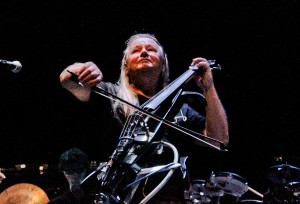 It’s really awful!
It’s really awful!
Thierry: It was crazy! And there were a lot of traffic jams. And in order to pass at check points you had to give money so we could pass quicker.
Wow!
Thierry: If not we would have arrived much later.
Thierry, could you please give us more details about your Russian grandfather?
Thierry: I don’t know the full story about my Russian grandfather. When he came to France he didn’t want to talk about his past. He didn’t talk Russian with us, so I didn’t learn Russian. I just know that he came from Arkhangelsk, maybe he was somebody to cut trees in the woods. The First World War started, and he got drafted and captured, and then he came as a war prisoner to Belgium. Then he managed to flee and there in Belgium he met his future wife. She was from Belgium, and they came to live in France.
That’s a very interesting story!
Thierry: But I don’t know more.
Thank you. May we ask some questions about future of the band? Was yesterday’s performance recorded and will it release somehow?
Gerard: Yes, we have an audio recording. Maybe not everything but some extracts would be issued. But we don’t know yet. We have to listen, if it worth to…
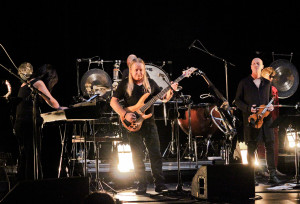 You have also a lot of Art Zoyd’s unreleased material you’ve found in your studio, will it be published someday?
You have also a lot of Art Zoyd’s unreleased material you’ve found in your studio, will it be published someday?
Gerard: Yes, we’re planning to publish 11 CD’s or even more, there are live and studio versions. We have very early live cuts of some pieces, they sound very funny sometimes.
And what about new Art Zoyd music?
Gerard: Everybody has his own projects. I have a lot of new projects in my mind that I want to fulfill. And Thierry also.
Will you continue working together?
Gerard: We did so much together with this Art Zoyd reunion project. Maybe we would like to compose something together to put it into this concert. But we don’t want to say «yes, we will do it» – or not. If it happens – it happens.
Gerard, at the latest albums and on the concert you have been playing mostly synthesizers, not the violin, why?
Gerard: Oh, I have problems with my hands. Since 1988 I have problems with my health (arthritis, – ed.), so I have to stop playing violin.
Sorry to hear that… By the way, you mentioned that making music for you is like architecture. What architectural style can you compare your music?
Editta: Bauhaus?
Gerard: (laughs) Bridges!
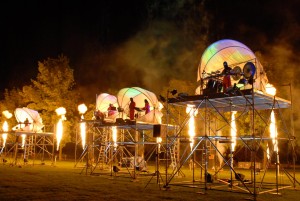 What?
What?
Gerard: Bridges. I wouldn’t compare it to the certain style [of architecture] but to the bridges as an object, which unites two sides of the river together. It gives perspectives, it gives a direction.
Great! Few little questions to Thierry. Yesterday you not just played the bass and cello, very groovy and powerful, but you also sung in “Baboon’s Blood”. You voice sounds very mighty. Do you use some sound effects?
Thierry (with hoarse and growl sounds): IT’S MY VOICE!!!!
(Everybody laughing.)
Thierry: It’s only little bit of chorus. Nothing more. During all the years I researched my voice, I researched expression, styles, harmonics, lyrics, theatricality and so on.
And you have very beautiful electrical cello. Please tell a couple of words about this instrument.
Thierry: Visually it’s not very beautiful. It’s not like a real cello, it’s a stick. The vibrations are capturing by a piezo microphone on the bridge. Since the 80’s I have my own way of amplifying. Working with cello for a long time I developed my own cello sound. I want my cello sounds like a classical instrument, but if I need something different I use an effects pedal for distortion and so on.
Gerard: Thierry doesn’t want that cello to sound like electric guitar, rather like cello. He searches for that specific harmonics that you can hear only when you are very close to the instrument. These overtones can be very fine with the sounds if they will be amplified.
Having three drummers on stage is more musical or visual thing?
Gerard: First of all, musical. This is normal lineup of Art Zoyd nowadays. It produces a lot of energy. We could have a bigger cast but it’s very difficult economically. This is why we use two keyboards and one piano which got different sounds. We won’t be able to perform like nine musicians at the time, it’s too expensive.
By the way, you used the crowdfunding to arrange this concert, was it successful?
Gerard: Of course these are difficult times now. So when considering this project the band decided not to rely purely on public money, but also ask their fan community to contribute to the project. This has been a wonderful success in financial terms, but also because there is a strong sense of community now – between Art Zoyd and all the people contributed to this project.
So thank you very much for such a great conversation. We are very happy to be at this grandiose performance you made yesterday. And we hope for the continuation!
Thank you!
… and the continuation, as it has been already mentioned, will take place on December 7th 2016, Le phénix scène nationale, Valenciennes, France. Be there if you can!
Elena SAVITSKAYA,
Vladimir MILOVIDOV
Thanks to Editta Brown and Ekaterina Vinogradova for the help with translation.

